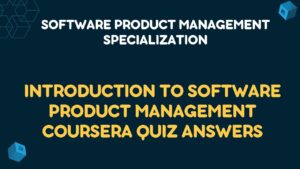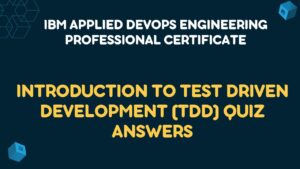Get All Weeks Symmetric Cryptography Coursera Quiz Answers
Table of Contents
Symmetric Cryptography Week 01 Quiz Answers
Quiz 1: Caesar Cipher Quiz Answers
Q1. You agreed to use a Caesar cipher with a key of k=5 with a friend. While sitting in a group, the friend hands you over a message that says “QNGWFWD”. Decrypt the message.
Q2. Suppose you actually forgot the key. How many decryption computations of the cipher text “QNGWFWD” do you need to perform to reach to the plaintext? (Consider the worst case.)
ViewQ3. Your friend proposes an update in the key and suggests a new key, k=523. How many cyclic shifts do you need to perform using the new key? You want to minimize the number of cyclic shifts on the letters.
ViewQuiz 2: Modulo Operation and Caesar Cipher Quiz Answers
Q1. Let’s use a modified Caesar Cipher where c = (p+2x) mod 26, where c and p are the ciphertext and the plaintext, respectively, and x is the key. How many distinct keys, producing distinct encryption/decryption transformations, are there now?
ViewQ2. For c = (p+2x) mod 26, where c, p, and x are the ciphertext, the plaintext, and the key, respectively, what is the corresponding decryption? Select all that works.
View2.p = (c-2x) mod 26
Q3. Let’s now use a modified Caesar Cipher where c = (p+3x) mod 26, where c and p are the ciphertext and the plaintext, respectively, and x is the key. How many distinct keys, producing distinct encryption/decryption transformations, are there now?
ViewQuiz 3: Vigenere Cipher Quiz Answers
Q1. Let’s use Vigenere Cipher to encrypt English text, ignoring capitalization and other symbols beyond English alphabets. The key is of length 1 and of value “Y” or 24, i.e., the key is “Y”. Which of the following statements is false?
ViewQ2. Vigenere cipher is used with a key “XO”. What is the ciphertext corresponding to the plaintext, DRAGON?
ViewQ3. Vigenere cipher is used with a key “XO” to encrypt a long English book, comprised of English alphabet letters and ignoring capitalization and other symbols. The key length is fixed, i.e., the key is 2 alphabets long. What is the number of possible distinct keys?
ViewQ4. Vigenere cipher is used with a key “XO” to encrypt a long English book. You order the letters appearing in the encrypted book in the decreasing order of frequency (i.e., from the most frequently appearing to the least frequently appearing), and the result is: RGZNFIBJWPESCXHTMYAUOLDKVQ. Which ciphertext letters correspond to the plaintext letter E (which is the most frequent letter in the plaintext)? Apply all those that apply.
View2.R
Symmetric Cryptography Week 02 Quiz Answers
Quiz 1: Rail Fence Cipher and Permutation Cipher
Q1. The Rail Fence cipher uses 4 rows/rails (the example in the lecture used 3). What is the ciphertext (the outcome of the rail fence cipher) for MEETMELATER?
ViewQ2. A Permutation Cipher has a key length of 5, e.g., one key can be [3 2 1 4 5]. How many possible keys are there?
ViewQ3. The plaintext MEETMELATER gets processed by a Permutation Cipher (with a key of [2 3 5 4 1] and no padding with extra letters. What is the corresponding ciphertext?
ViewQ4. The plaintext MEETMELATER gets processed by a Permutation Cipher (with a key of [2 3 5 4 1] and with padding using the letter “z” (Alice and Bob agree to use the letter z for padding). What is the corresponding ciphertext?
ViewQuiz 2: Product Cipher Quiz Answers
Q1. The plaintext MEETMELATER gets processed by a product cipher, comprised of Caesar Cipher (with a key of 23) and Permutation Cipher (with a key of [5 3 1 4 2] and no padding with extra letters). What is the corresponding ciphertext?
ViewQ2. The same product cipher in the previous question, comprised of Caesar Cipher and Permutation Cipher (with a key of length 5), is again used but with different keys. Given a plaintext, how many distinct ciphertexts can there be?
ViewQ3. The same product cipher in the previous question, comprised of Caesar Cipher and Permutation Cipher (with a key of length 5), is used to encrypt a long English book (ignoring capitalization and other symbols beyond English letters). Your friend makes the following claims. Select all those that are correct.
View2.”The ordering between the Caesar and the Permutation does not matter within the product cipher, so we can decrypt it in any order.”
3.”If we replace the Caesar Cipher with a Monoalphabetic Cipher, then it becomes harder to crack by an attacker (who does not know the key).”
Symmetric Cryptography Week 03 Quiz Answers
Quiz 1: Ideal Block Cipher Quiz Answers
Q1. You are given a stream cipher and a block cipher with a block size of 64 bits. The data input is 32 bits. How many bits do you need to pad before processing the data input using a stream cipher?
ViewQ2. The block cipher supports input/output of 64 bits. Which of the following is true about the key storage requirement?
ViewQ3. A block cipher takes a 3-bit plaintext and outputs a 3-bit ciphertext. If the cipher is an ideal block cipher, how many reversible transformations (keys) can it have?
ViewQuiz 2: DES Quiz Answers
Q1. True or False: DES is an ideal block cipher.
ViewQ2. True or False: DES displaying Avalanche Effect is a limitation because it describes that an error occurring in one of the rounds propagate through the rest of the rounds.
ViewQ3. An attacker is equipped with a computer that performs 10 trillion (10^13) DES decryptions per second, what is the average time required, in hours, for a brute force attacker to break DES?
ViewQ4. Which of the followings are true about Feistel Cipher? Select all that applies.
View2.Feistel Cipher is a product cipher.
3.Feistel Cipher processes the data in halves.
Symmetric Cryptography Week 04 Quiz Answers
Quiz 1: 3-DES and 4-DES Quiz Answers
Q1. Triple-DES or 3-DES encryption can be characterized by the following: C=Enc(K3,Dec(K2,Enc(K1,P))). Each keys, K1, K2, K3 are 56-bits-long and are independent to each other (the three-key version). The DES block size is 64 bits.
Using the big O notation, which of the following best describe the meet-in-the-middle attacker’s storage requirement?
ViewQ2. Triple-DES or 3-DES encryption can be characterized by the following: C=Enc(K3,Dec(K2,Enc(K1,P))). Each keys, K1, K2, K3 are 56-bits-long and are independent to each other (the three-key version). The DES block size is 64 bits.
Using the big O notation, which of the following best describe the meet-in-the-middle attacker’s encryption/decryption computational effort?
ViewQ3. Triple-DES or 3-DES encryption can be characterized by the following: C=Enc(K3,Dec(K2,Enc(K1,P))). Each keys, K1, K2, K3 are 56-bits-long and are independent to each other (the three-key version). The DES block size is 64 bits.
The attacker now does not have known plaintext-ciphertext pair that it can use for her cryptanalysis. Using the big O notation, which of the following best describe the attacker’s encryption/decryption computational effort?
ViewQ4. Quadruple-DES or 4-DES encryption can be characterized by the following: C=Enc(K4,Enc(K3,Enc(K2,Enc(K1,P)))). Each keys, K1, K2, K3, K4, are 56-bits-long and are independent to each other. The DES block size is 64 bits.
Using the big O notation, which of the following best describe the meet-in-the-middle attacker’s storage requirement?
Q5. Quadruple-DES or 4-DES encryption can be characterized by the following: C=Enc(K4,Enc(K3,Enc(K2,Enc(K1,P)))). Each keys, K1, K2, K3, K4, are 56-bits-long and are independent to each other. The DES block size is 64 bits.
Using the big O notation, which of the following best describe the meet-in-the-middle attacker’s encryption/decryption computational effort?
ViewQ6. Quadruple-DES or 4-DES encryption can be characterized by the following: C=Enc(K4,Enc(K3,Enc(K2,Enc(K1,P)))). Each keys, K1, K2, K3, K4, are 56-bits-long and are independent to each other. The DES block size is 64 bits.
The attacker now does not have known plaintext-ciphertext pair that it can use for her cryptanalysis. Using the big O notation, which of the following best describe the attacker’s encryption/decryption computational effort?
ViewQuiz 2: AES Quiz Answers
Q1. What is the block size for AES in Bytes?
ViewQ2. Which of the following key lengths does AES support? Select all that applies.
View2.128 bits
3.192 bits
Q3. Which of the followings correspond to transposition only (no substitution)?
ViewQ4. Which of the followings use the key?
ViewQ5. Which of the followings are true about AES? Select all that applies.
View2.AES involves both substitution and transposition.
Symmetric Cryptography Week 05 Quiz Answers
Quiz 1: Block Cipher Operation Modes
Q1. Which of the following describes the 2nd block encryption output of CBC mode (C2). The followings are given: E (an encryption cipher function), K (the key). C1 (the cipher output from the 1st block encryption), P2 (the plaintext for the 2nd block), and XOR (and exclusive-or function). For example, XOR(x,y) indicate the bit-by-bit XOR between the two bit vectors x and y, and E(K,P2) is the encryption output when using the key K and the plaintext P2.
ViewQ2. Which of the following operation modes do not require padding (if the data does not fill the block)? Check all that applies.
View2.CTR
3.CFB
Q3. Which of the followings describe the 2nd block encryption output (C2) of OFB mode? The followings are given: E (an encryption cipher function), K (the key). C1 (the cipher output from the 1st block encryption), P2 (the plaintext for the 2nd block), P1 (the plaintext for the 1st block), and XOR (and exclusive-or function). For example, XOR(x,y) indicate the bit-by-bit XOR between the two bit vectors x and y, and E(K,P1) is the encryption output when using the key K and the plaintext P1.
ViewQ4. Suppose a small, low-power device experiences that a real-time computation of the encryption/decryption function is burdensome (e.g., serving as the bottleneck of the performance) and wants to compute the encryption/decryption functions offline (e.g., computed before the plaintext/ciphertext). Which of the following block cipher operation modes support such feature? Check all that applies.
ViewCTR
Q5. You are given a block cipher with a block size of 64 bits. Given a data input of 32 bits, how many bits do you need to pad if the using the ECB operation mode?
ViewQ6. You are given a block cipher with a block size of 64 bits. Given a data input of 32 bits, how many bits do you need to pad if the using the CFB operation mode?
ViewQ7. Alice and Bob is not synchronized in time, and their clock frequency is different. Which of the block cipher operation modes would be affected by such lack of synchronization? Check all that applies.
ViewQ8. Suppose Pi indicates the plaintext input for the block cipher i from the sender’s perspective, e.g., P2 is the plaintext input for the 2nd block cipher, and Ci is the ciphertext input for the block cipher i from the receiver’s perspective. (If there were no errors, Ci is also the ciphertext output of the block cipher i from the sender.) Which of the following scenarios causing errors affect C3 (and cause error in C3)? Select all that applies.
View2.Error occurs on P1 for CBC Mode.
Symmetric Cryptography Course Review
In our experience, we suggest you enroll in Symmetric Cryptography courses and gain some new skills from Professionals completely free and we assure you will be worth it.
Symmetric Cryptography for free, if you are stuck anywhere between a quiz or a graded assessment quiz, just visit Networking Funda to get Symmetric Cryptography Coursear Quiz Answers.
Get All Course Quiz Answers of Machine Learning Specialization
Cryptography and Information Theory Quiz Answers
Symmetric Cryptography Coursera Quiz Answers
Asymmetric Cryptography and Key Management Quiz Answers
Cryptographic Hash and Integrity Protection Quiz Answers




